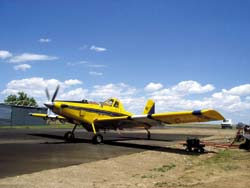|
|
 |
| SW Aviator Magazine is available in print free at FBOs and aviation-related businesses throughout the Southwest or by subscription. |

|
 |

|
 |
 |
 |
|
The web's most comprehensive database of Southwest area aviation events.
|

|
 |

|
 |
|
Featured Site:
|
|
|
 |
|
A continuosly changing collection of links to our favorite aviation related web sites.
|

|
 |

|
 |
 |
|

|
S.E.A.T.s
|
 Story by Mary Stuever Story by Mary Stuever
Photos by Louie Casaus
As a twenty-year veteran firefighter, I have to admit I was skeptical when I first heard about single engine airplanes being used to dump fire retardant on fires. I wondered how small planes could be as effective as the large military bombers. However, a visit to the Single Engine Air Tanker (SEAT) base at the Las Vegas, New Mexico Municipal Airport convinced me these small planes are the answer to problems presented by the current aging large air tanker fleet.
The SEAT I toured in Las Vegas is the largest single engine plane in the world, with a wingspan 60 feet across. The Air Tractor AT-802, built in Olney, Texas can carry 800 gallons in its hopper. Unlike the large multi-engine air tankers we normally envision, the Air Tractor’s versatile storage area can be loaded with water, retardant, or another fire fighting liquid known as wet water with reduced surface tension. Typically, the plane’s first load is water, which can either be dropped on the fire if the reported fire is found, or dumped elsewhere without sacrificing an expensive load of slurry. When the plane isn’t being used on fires, the hopper can also be loaded with seed, fertilizer, or any other aerial applications.
The larger bombers carry 2,000 to 3,000 gallons of retardant, which is loaded on the planes from permanently placed vats at designated air tanker bases. Depending on the model, these planes can drop their retardant in one pass or in several separate loads. In New Mexico, the three air tanker bases are in Albuquerque, Alamogordo, and Silver City. SEATs, on the other hand, are loaded from easily transported trailer-mounted mixing tanks. Any airstrip, or even stretch of highway, can be set up to refuel and reload the small planes in the time it takes to drive to the location. Therefore, by placing the SEAT operation closer to the fire, the SEAT has a significantly faster turn around time between loads.
The plane is also plumbed for rapid turnaround, and can be refueled and reloaded with the engine still running. The average "pit-stop" time is between three and five minutes. Louie Casaus, Las Vegas District Forester and a wildfire incident commander, described being on the ground during a recent fire utilizing the SEAT. "It would seem just a matter of minutes since the plane left, before we’d hear it coming back again. It was just amazing."

Casaus and other incident commanders have been especially impressed with the pinpoint accuracy of the retardant drops. Armed with built-in GPS equipment, the plane’s state-of-the-art technology provides precision guidance. This ability to lay the retardant exactly in needed locations actually reduces the amount of overall retardant needed to fight the fire, providing one more cost-saving measure in the operation.
State-of-the-art technology is apparent in various safety measures built into the plane as well, including excellent pilot visibility, a rugged airframe, and features that make the plane crash-worthy. Pilot Dan Rinner of Aztec, New Mexico recently had an incident that might have proven fatal in a different craft. After dropping a retardant load his plane hit the treetops, but he was able to fly the plane back to the airport and make a safe landing. Although the plane sustained damage, the pilot escaped injury. The Clovis-based company, Aero Tech, Inc., brought in a replacement plane and the SEAT operation was only temporarily out-of-service.
"Safety is the primary focus of our operation," explains Army Ranger Harry Weeks. Now a certified "SEAT Manager," Weeks is the official agency employee responsible for the safety and use of the aircraft. Not only does the aircraft not fly without a SEAT Manager on the ground to supervise the operation, but a certified crash/rescue unit must also be on-call at the airstrip. At the Las Vegas Municipal Airport, this service is contracted from the Las Vegas Fire Department. The City of Las Vegas supports the SEAT operation with the services of the city’s Public Water Works as well.
In addition to hosting the SEAT operation in Las Vegas, the New Mexico State Forestry Division also sponsors a SEAT operation based out of Ruidoso in cooperation with the Village of Ruidoso. Aero Tech, Inc. has the contract for that operation as well, offering a truly New Mexican solution towards addressing the national issue of air tanker availability. |
Click here to return to the beginning of this article.  |
|